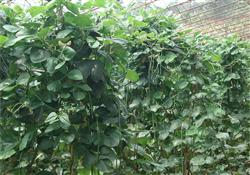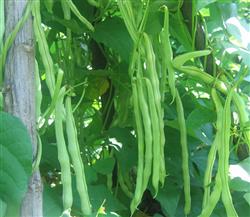Analysis on the causes of excessive growth of beans in greenhouse and its control countermeasures

The reasons for excessive growth of vegetables in summer are different. Practice has proved that the greenhouse beans are most likely to cause excessive growth in summer. The main reasons can be classified into two categories: First, the main reason for excessive growth of seedlings is too high temperature, especially at night. In addition, excessive nitrogen and water, too dense sowing, and delayed seedling transfer are also easy to cause excessive seedling growth. The excessive growth at seedling stage can be divided into the following four categories: ① The excessive growth is most likely to be caused during the period from seedling emergence to cotyledon development. At this time, the excessive growth is mainly due to over-dense seeding and failure to remove the mulch in time after emergence, making the seedlings too crowded. 2. If the temperature is not lowered in time after emergence, it is easy to over-elongate the epicotyl of the seedling and overgrow it. (3) Cotyledons expand to 2-3 leaf stage, and seedlings are not thinned in time, or seedlings are not planted in time due to high temperature (transplanting seedlings into bowls), so that seedlings are overcrowded and overgrown.④ From the time of false planting to the time of planting, the seedlings with too high soil and air humidity in the seedbed, too much nitrogen fertilizer in the nutrient soil, and failure to ventilate and transmit light in time and sparse and crowded seedlings in management will also grow excessively. Solution: 1. Sowing density should not be too large, so as not to crowd seedlings after emergence. At the same time, the ground cover was removed in time after about 30% of the seedlings emerged. 2. Thinning and planting in time. 3. Strengthen ventilation and light transmission, control temperature and humidity. Ventilation and light transmission, lowering temperature and humidity, strengthening low temperature training should be carried out after seedling emergence and before planting to control excessive growth of seedlings. 4. Reasonable fertilizer and water management. In the preparation of nutrient soil, attention should be paid to the amount of phosphorus and potassium fertilizer, and the amount of nitrogen fertilizer should be controlled. Water and topdressing should be strictly controlled in seedbed. When topdressing is needed, nitrogen fertilizer should not be applied. 5. Thinning in time. About 20 days before planting, seedlings often appear overcrowding phenomenon, at this time should be appropriate to move seedlings, so that large and small seedlings separate, and expand the survival space of individual plants. 6. Potions control excess growth. Once the seedlings grow too long, in addition to the above measures, 50% chlormequat 2000-2500 times liquid spray can also be used. 2. Excessive growth of plants The causes of excessive growth of plants also include temperature, humidity, excessive nitrogen fertilizer or excessive nutrition. Solution: 1. Apply less quick-acting nitrogen fertilizer: In the cultivation process of various crops, especially in the pod setting period, due to excessive nitrogen fertilizer, it often causes excessive growth, serious flower drop, excessive nutrient growth, and insufficient reproductive growth. Therefore, it is better to apply less nitrogen fertilizer than more; 2. Nutritional regulation: according to the characteristics of humic acid foliar fertilizer and amino acid foliar fertilizer that can control growth potential at a certain concentration, combined with disease prevention and pest control, hormone drugs such as auxin and chlormequat have good effects, and the fruit is pure and the yield is high; 3. hoeing and root cutting: when the plant grows too vigorously, the "hoeing method" can be adopted. On the one hand, it can increase soil permeability, on the other hand, it can break some roots, which is conducive to secondary root penetration; 4. Small water irrigation: meet crop demand while reducing soil moisture; 5. Auxiliary measures such as sunshade net to cool down.
- Prev

The planting and management method of multi-pod setting of beans
Beans are difficult to manage is known to many vegetable farmers, easy to steep grow difficult to set pods, and even drop flowers and pods occur from time to time, so what is the reason for the difficulty of setting pods? 1. The planting density should be reasonable. The best planting age is when the heart leaves of bean seedlings are just unfolded. The reasonable line spacing of beans is usually 60 cm.
- Next

Seize the time to control eggplant, melon and balsam pear diseases
The new leaves become narrow, shriveled, hardened and twisted, the diseased plants are obviously dwarfed, it is difficult to sit, even if they sit, they are deformed, hardened and mottled on the surface. % 26rdquo; Recently, a farmer took a sick balsam pear vine, anxious to find the city plant protection station consultation and reflect to the author, asked what disease, and seek solutions...
Related
- Where is it suitable to grow horseradish in China? it is expected to see the middle altitude horseradish in Alishan.
- How to prevent tomato virus disease reasonably? (Control methods included)
- Many people like to plant towel gourd on the balcony. What are the main points of this method and management?
- What crops can chili peppers be mixed with?
- Fertilization techniques and matters needing attention in Tomato
- What are the grafting techniques for peach seedlings in spring?
- Harm and control methods of root swelling disease of Chinese cabbage
- What are the pests of sweet potatoes? How to prevent and cure it?
- Symptoms, causes and Control methods of navel Rot in Tomato
- The cause of "Cucumber rotten bibcock" in Farmers' planting Cucumber and its Control Plan

